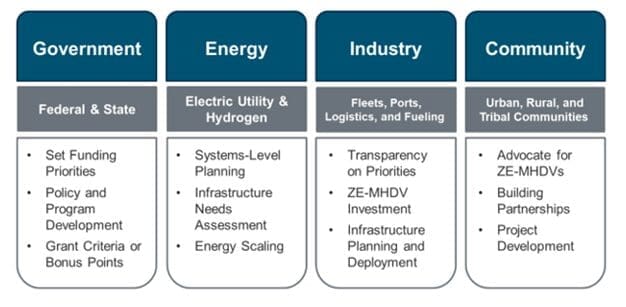In March 2024, the Joint Office of Energy and Transportation released the National Zero-Emission Freight Corridor Strategy, which aims to decarbonize and advance zero-emission freight along the United States main shipping corridors. This plan’s goal is to advance the deployment of zero-emission medium- and heavy-duty vehicles (ZE-MHDVs) and the infrastructure needed to enable ubiquitous access to charging and hydrogen refueling along our nation’s prominent freight corridors. Through the U.S. National Blueprint for Transportation Decarbonization, the US has committed to implement programs that promote 30% ZE-MHDV sales by 2030 and 100% by 2040. This comprehensive strategic plan provides an approach to align investments and accelerate sustainable and scalable deployment of a robust ZE-MHDV infrastructure.


Source: National Zero-Emission Freight Corridor Strategy
The freight sector is a significant source of greenhouse gas emissions in the United States, accounting for about 28% of the transportation sector’s emissions and 7% of the total emissions in 2019. The freight sector is also expected to grow in the coming years, as e-commerce and global trade increase the demand for goods movement. The strategy aims to reduce the environmental and public health impacts of freight transportation, while enhancing the competitiveness and resilience of the U.S. economy.
The strategy will be implemented through a combination of federal funding, regulatory actions, and stakeholder engagement. The strategy will leverage existing programs and authorities, such as the Fixing America’s Surface Transportation (FAST) Act, the Congestion Mitigation and Air Quality Improvement (CMAQ) Program, and the Diesel Emissions Reduction Act (DERA). The strategy will also explore new opportunities and incentives, such as grants, loans, tax credits, and emissions standards, to accelerate the adoption of zero-emission vehicles and infrastructure. The strategy will involve collaboration and consultation with state, local, tribal, and private sector partners, as well as environmental justice and labor organizations, to ensure that the strategy is responsive to the needs and interests of diverse stakeholders.


Source: National Zero-Emission Freight Corridor Strategy
The Role of Electric Semi-trucks
One of the key components of the strategy is to promote the use of electric semi-trucks, which are heavy-duty vehicles that run on batteries instead of diesel. Electric semi-trucks have the potential to significantly reduce greenhouse gas emissions, air pollution, noise, and fuel costs, compared to conventional diesel trucks. Electric semi-trucks also have lower maintenance and operational costs, as they have fewer moving parts and do not require oil changes or exhaust after-treatment systems. Electric semi-trucks can also benefit from the existing and planned network of charging stations, which can provide fast and convenient access to electricity.
Several electric semi-truck manufacturers have emerged in recent years, offering different models and specifications of zero-emission vehicles. Some of the notable electric semi-truck manufacturers are:
- Tesla unveiled its Tesla Semi in 2017 and started production in 2021. The Tesla Semi claims to have a range of 300 to 500 miles, a top speed of 65 mph, and a 0-60 mph acceleration of 20 seconds. The Tesla Semi also features a futuristic design, a spacious cabin, and a high-tech dashboard.
- Nikola, which announced its Nikola One and Nikola Two models in 2016 and 2019, respectively. The Nikola One and Two are hydrogen-electric semi-trucks, which use hydrogen fuel cells to power electric motors. The Nikola One and Two claim to have a range of 500 to 750 miles, a top speed of 65 mph, and a 0-60 mph acceleration of 30 seconds. The Nikola One and Two also feature a sleek design, a comfortable interior, and a touch-screen display.
- Daimler, which launched its Freightliner eCascadia and eM2 models in 2018 and started production in 2022. The Freightliner eCascadia and eM2 are battery-electric semi-trucks, which use lithium-ion batteries to power electric motors. The Freightliner eCascadia and eM2 claim to have a range of 250 to 300 miles, a top speed of 65 mph, and a 0-60 mph acceleration in 25 seconds. The Freightliner eCascadia and eM2 also feature a conventional design, a spacious cab, and a digital instrument cluster.
- Volvo, which introduced its Volvo VNR Electric model in 2019 and started production in 2021. The Volvo VNR Electric is a battery-electric semi-truck, which uses lithium-ion batteries to power electric motors. The Volvo VNR Electric claims to have a range of 150 to 250 miles, a top speed of 65 mph, and a 0-60 mph acceleration of 23 seconds. The Volvo VNR Electric also features a modern design, an ergonomic interior, and a driver-assist system.
Greenlane and Tesla Announce Plans for EV Charging Corridors
Beyond the government plans, private groups are investing in creating pathways towards decarbonizing shipping lanes. Greenlane is a joint venture between Daimler Truck North America LLC, NextEra Energy Resources, LLC, and BlackRock, and they announced a plan to build a commercial charging corridor between LA and Las Vegas. The initial charging locations will be in Colton, Barstow and Baker, California. The plan calls for the Colton site to have over 60 chargers, including 400 kW Direct Current Fast Chargers (DCFC) to speed charging of ZE-MHDVs. 200 kW DCFC charging options onsite will allow for long-duration and overnight charging, and the site will also include multiple passenger vehicle stations as well. The site will also include Megawatt Charging Systems when they become available and plans to open in late 2024. The sites will feature modern facilities with food options, restrooms, and other amenities. Greenlane’s goal is to develop a nationwide network of commercial charging infrastructure locations across the US and will also be designed to provide hydrogen refueling.
Tesla was snubbed by the funding program, but still plans to build an electric charging corridor from Fremont California to Laredo Texas. Their plan calls for 9 charging locations along the corridor, and it’s the first charging network that would allow for both long-distance and regional electric trucking. The 1,800-mile route would connect Tesla’s two North American vehicle factories, as well as the one that is delayed in Mexico. Each station would be equipped with eight 750kW chargers for Tesla Semis, and four open to other electric trucks. Tesla’s goal is to build infrastructure to sell its Semi, which is years behind schedule with only about one hundred built to date.
These announcements show that the private sector is also committed to accelerating the transition to zero-emission medium and heavy-duty vehicles, and that they are willing to invest in the necessary infrastructure to support them. EV charging corridors can reduce range anxiety, lower operational costs, and increase efficiency for electric trucking. They can also stimulate economic growth, create jobs, and improve air quality along major transportation routes. As more companies join the efforts to decarbonize the freight sector, EV charging corridors will become more widespread and accessible, paving the way for a cleaner and greener future.








